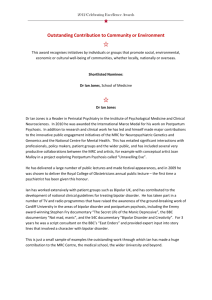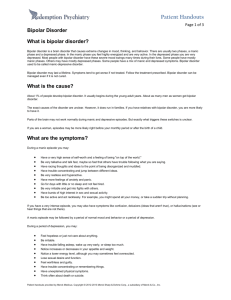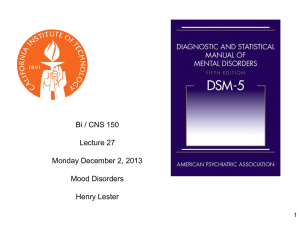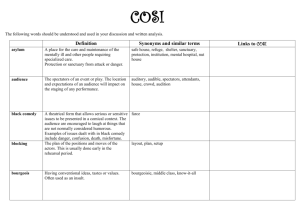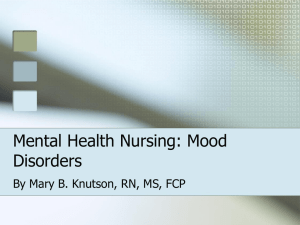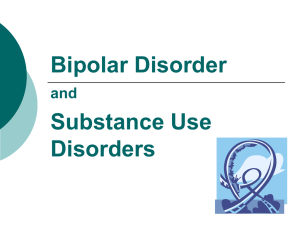Defining bipolar mood states with quantitative measurement of
advertisement
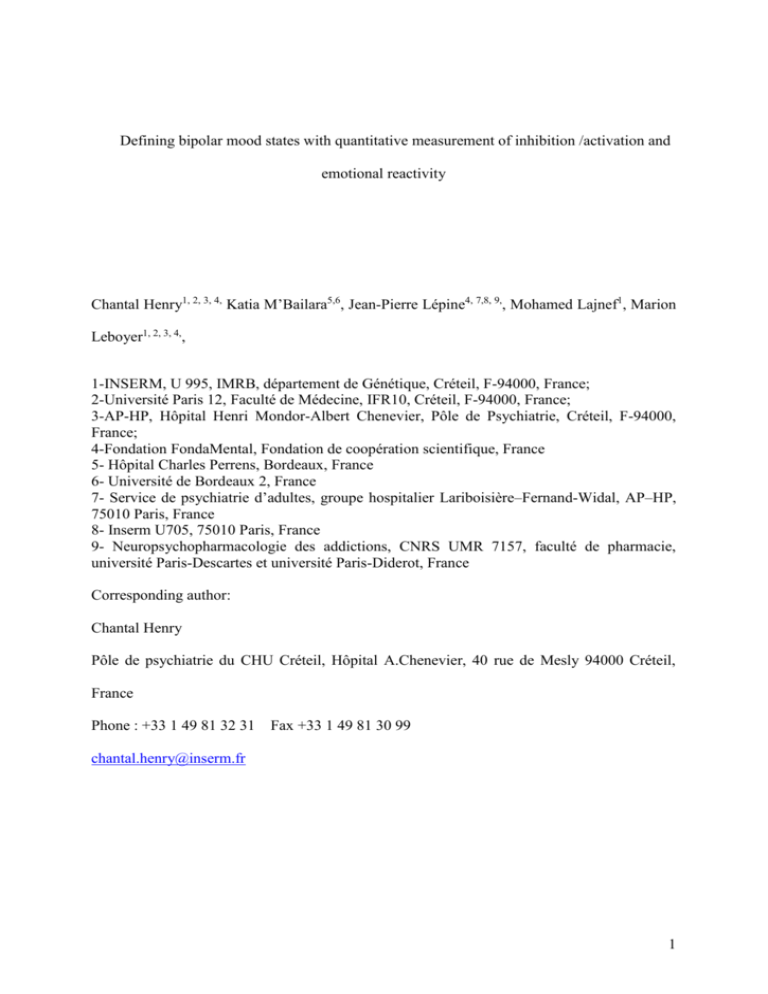
Defining bipolar mood states with quantitative measurement of inhibition /activation and emotional reactivity Chantal Henry1, 2, 3, 4, Katia M’Bailara5,6, Jean-Pierre Lépine4, 7,8, 9,, Mohamed Lajnef1, Marion Leboyer1, 2, 3, 4,, 1-INSERM, U 995, IMRB, département de Génétique, Créteil, F-94000, France; 2-Université Paris 12, Faculté de Médecine, IFR10, Créteil, F-94000, France; 3-AP-HP, Hôpital Henri Mondor-Albert Chenevier, Pôle de Psychiatrie, Créteil, F-94000, France; 4-Fondation FondaMental, Fondation de coopération scientifique, France 5- Hôpital Charles Perrens, Bordeaux, France 6- Université de Bordeaux 2, France 7- Service de psychiatrie d’adultes, groupe hospitalier Lariboisière–Fernand-Widal, AP–HP, 75010 Paris, France 8- Inserm U705, 75010 Paris, France 9- Neuropsychopharmacologie des addictions, CNRS UMR 7157, faculté de pharmacie, université Paris-Descartes et université Paris-Diderot, France Corresponding author: Chantal Henry Pôle de psychiatrie du CHU Créteil, Hôpital A.Chenevier, 40 rue de Mesly 94000 Créteil, France Phone : +33 1 49 81 32 31 Fax +33 1 49 81 30 99 chantal.henry@inserm.fr 1 Objectives: Mood state heterogeneity in bipolar disorder leads to confusion in diagnosis and therapeutic strategies. Recently, the Systematic Treatment Enhancement Program for Bipolar Disorder (STEP-BD) showed that two-thirds of bipolar-depressed patients had concomitant manic symptoms, these characteristics being linked to a more severe form of bipolar disorder. Moreover, manic symptoms occurring during bipolar depression are associated with mood switches induced by antidepressant. It is thus important to best characterize mood episodes with mixed features in order to improve our understanding of the etiopathology and to choose the most appropriate treatment. As dimensional approach can better describe phenomena that are distributed continuously without clear boundaries, we used the MATHYS scale, constructed on a dimensional approach. The aim of the study is to determine whether two dimensions (activation/inhibition and emotional reactivity) improve assessment of bipolar states in which both manic and depressive symptoms are associated. Methods: We included 189 bipolar patients and 90 controls. Bipolar patients were distinguished between those with a major depressive episode without manic symptoms, a major depressive episode with manic symptoms, a mixed state and a manic state. The MATHYS scale provides a total score, quantifying an inhibition/activation process, and a score for emotional reactivity (intensity of emotions). Results: We demonstrated that there is a continuum ranging from inhibition to activation (respectively from major depressive episodes without manic symptoms to manic states), with a gradual increase in the severity of the activation. Regarding emotional reactivity, results are quiet different since only major depressive episodes without manic symptoms are characterized by emotional hypo-reactivity while major depressive episodes with manic symptoms, manic and mixed states exhibited emotional hyper-reactivity. Conclusions: The MATHYS scale, providing a score for inhibition/activation process and a score for emotional reactivity, is clearly useful to 2 distinguish bipolar depressive episodes without manic symptoms from those with manic symptoms. This last type of depression appears to belong to a broad spectrum of mixed state. To go further we need to explore if these two types of depression are underlined by different mechanisms and what is the most appropriate treatment for each of them. Key words: bipolar disorder, depressive state, mixed state, DSM-V, emotional reactivity, dimensional approach, MATHYS Scale. 3 Introduction Mood state heterogeneity in bipolar disorders has led to confusion in diagnosis and therapeutic strategies. Contrary to Kraepelin (1), who described six mixed states, DSM-IV (2) narrowly defines mixed episodes on the basis of full manic and full depressive syndromes being present at the same time, for at least one week, in only bipolar I patients. However, recent studies highlight the diversity of mood states in which both manic and depressive symptoms are associated. Koukopoulos was the first to draw attention to the need to recognize manic or hypomanic features that may arise in conjunction with bipolar depressive episodes (3). Benazzi (4) suggested defining “depressive mixed states” by the presence of three manic symptoms during bipolar II depressive episodes. Based on a broader ICD-10 (5) definition of a mixed episode, Suppes et al (6) described “mixed hypomania” for episodes simultaneously presenting hypomanic and depressive features. More recently, the Systematic Treatment Enhancement Program for Bipolar Disorder (STEP-BD) has shown that two-thirds of bipolar depressed patients had concomitant manic symptoms (7). In the STEP-BD study, patients with mixed features had more severe characteristics, such as illness onset at an early age, more bipolar I subtype, more rapid cycling in the past year, and a more frequent history of suicide attempts. Moreover, Frye et al. (8) showed that minimal manic symptoms at baseline coexisting with an otherwise full syndromal form of bipolar depression are associated with antidepressant treatment-emergent mania or hypomania. A better assessment of the differences between pure and mixed bipolar depression is of a great clinical significance, as it may offer potential indicators of short-term prognosis and may help in the prescription of psychotropic drugs. 4 On the other hand, Kraemer et al (9) have defined a dimensional approach, in which clinical presentations are classified based on quantitative attributes rather than the assignment to categories. It should work best if describing phenomena that are distributed continuously without clear boundaries. Thus, a dimensional approach appears to be appropriate for defining the spectrum of mixed episodes. To apply this concept to mixed states, we built and validated the MATHYS (Multidimensional Assessment of Thymic States) scale to define mood states as a function of a dimensional approach assessing symptoms on their quantitative aspects (acceleration/retardation; increase/decrease) (more details in the method section) (10). This scale provided a total score quantifying an overall level of inhibition/activation and a score of emotional reactivity (hypo versus hyper). We have previously shown that (11) emotional hyper reactivity (feeling emotions with a higher intensity than usual) characterizes mixed and manic states. We aimed 1) to determine whether only one scale (MATHYS) could be used to assess all bipolar mood episodes, and 2) to determine whether two dimensions (activation/inhibition; emotional reactivity) can help defining bipolar states in which both manic and depressive symptoms are associated. 5 Method Participants Participants included control subjects and bipolar patients. Control subjects were recruited through advertisements in shopping areas and in sportive associations. Bipolar patients were in and outpatients recruited in a setting specialized in bipolar consultations or patients hospitalized in a department corresponding to a catchment area in Bordeaux (France). All patients had bipolar disorder, type I or II, and at the time of entry met the DSM-IV criteria for a full episode (depressed, manic or mixed). All subjects gave written informed consent, and the protocol was approved by the local ethics committee. Assessments All subjects (controls and bipolar patients) were assessed using the mood section of the French version of DIGS (Diagnostic Interview for Genetic studies), a structured interview providing DSM-IV diagnosis criteria (12). Severity of depressive and manic symptoms was further rated using the Montgomery-Asberg Depression Rating Scale (MADRS) (13) and the Bech and Rafaelsen Manic scale (MAS) (14). As there was no clinical tool to assess bipolar mood states dimensionally, we developed and validated a dimensional self-rated scale: MATHYS (Multidimensional Assessment of Thymic States). This scale was built a priori, with five quantitative dimensions, which vary from inhibition to activation. The goal was to generate a total score indicative of the overall level of inhibition/activation. Thus, classic dimensions, such as cognition, motivation, psychomotor agitation or retardation and sensory perception, were assessed quantitatively (i.e., racing thoughts or subjectively feeling that their thoughts occur slower, physical agitation or retardation, and increase or decrease in sense perception) (Example: My brain never stops/ My brain seems to be functioning in slow motion). We applied a similar concept to evaluate emotion, focusing only on the quantitative aspect (ie, 6 whether the patient felt emotion with normal intensity, greater intensity, or less intensity) (Example: My emotions are very intense/ My emotions are attenuated) The concept behind this scale involved exploring all bipolar mood states on a continuum using a score for inhibition/activation and exploring emotional reactivity rather than tonality of affect (euphoria/sadness). Manic and mixed states were better characterized by emotional hyper-reactivity, suggesting that all patients felt emotions with an unusual intensity, irrespective of the emotion (sadness, irritability, euphoria, and anxiety) (11). The scale is composed of a visual analog scale comprising 20 items related to how the individual feels during the previous week. Statistical analyses demonstrated a good validity for this scale, and a good internal consistency (Cronbach’s alpha coefficient = 0.95). The MATHYS scale is moderately correlated of both the MADRS scale (depressive score; r = -0.45) and the MAS scale (manic score; r = 0.56). This scale gives a total score assessing the activation/inhibition level and a score for emotional reactivity (hyper/hyporeactivity) (the English version of the scale can be found by following this link: [http://www.biomedcentral.com/content/supplementary/1471-244X-8-82S1.doc] (10). Statistical analyses Groups (bipolar mood episodes and control) were compared based on MATHYS, MADRS and MAS scales. Statistical methods consisted of Chi-square tests for comparisons of categorical variables (sex) and analysis of variance (ANOVA) for continuous variables: [MATHYS (total score and score of emotional reactivity), age, MADRS, MAS]. The score for emotional reactivity was obtained by adding items 3, 7, 10 and 18 (define by a principal component analysis, Henry et al., 2008). Post-hoc analysis using Tukey's procedure was used to calculate mean differences and to determine which means were significantly different from 7 one another. Finally, we analyzed whether there was a trend in the mean differences between bipolar mood episodes. Testing was 2-sided, with a significance level of 5%. Two-sided p values of 0.05 were considered statistically significant. We used SAS software (version 9.1; SAS Institute) for the analysis. 8 Results Characteristics of the groups The total sample of 279 subjects (189 bipolar patients and 90 controls) was composed of 92 (33%) men and 187 (67%) women, with a mean age at interview of 39.3 (±13.1) [14-72] years. There is no difference between control subjects and bipolar patients for age and gender. A total of 54.9% of patients (n=96) met the criteria for bipolar type I disorder. Among bipolar patients and according to DSM-IV criteria, 51 patients (27 %) had a major depressive episode without manic symptoms, 21 (11.1%) had mixed episodes, and 54 (28.6%) had hypomanic or manic episodes. As defined by STEP-BD (Golberg et al., 2009), 63 (33.3%) patients presented a major depressive episode associated with manic symptoms, but these patients did not fulfil the DSM-IV criteria for a mixed episode. As expected, all groups had different MADRS scores (F=152.4; ddl=4; p<0.0001). The highest score was observed for patients in a major depressive episode without manic symptoms and manic patients exhibited the lowest score. All groups had also different scores on the manic scale (MAS) (F=142.9; ddl=4; p<0.0001). The highest score was found in the manic group 17.6 (±6.8) while the group with a major depressive episode exhibited 1.3 (±2.1) and patients with a major depressive episode associated with manic symptoms had a mean score at 7.6 (±4.3). Dimensional characterization The total scores within all groups, based on the MATHYS scale for assessing inhibition/activation, were different (F=95.8; ddl=4; p<0.0001). The total score increased progressively from major depressive episode without manic symptoms to manic states (ranging from 58.6±27 for major depressive episode to 142.4±27.9 for manic states) (Table 1 and figure1). 9 Post-hoc analysis showed that the total score based on the MATHYS scale was different between the two subtypes of depression. Patients, with a major depressive episode without manic symptoms, exhibited lower scores than those with a major depressive episode with manic symptoms. By contrast, scores for major depressive episode with manic symptoms were not different for those from mixed states. The score assessing emotional reactivity was statistically different if the whole sample was considered (F=64.9; ddl=4; p<0.0001)(table 1 and figure 2). Post-hoc analysis showed that there were no difference among the scores for major depressive episode with manic symptoms, mixed states and manic states. By contrast, major depressive episodes without manic symptoms exhibited the lowest score among all groups. Relative to controls, and representative of normal emotional reactivity, depressed patients without manic symptoms had emotional hyporeactivity, whereas those with major depressive episode with manic symptoms exhibited emotional hyperreactivity. 10 Discussion Our results showed that the different bipolar mood states can be assessed using only onedimensional MATHYS scale which classifies the mood episodes using a continuum ranging from inhibition to activation. Major depressive episodes without manic symptoms displayed lower scores, underlying overall inhibition. As expected, the manic group had a higher activation score. Major depressive states associated with manic symptoms had scores that were similar to those of mixed states, as defined by DSM-IV (2). Emotional reactivity clearly helped to distinguish major depressive episodes without manic symptoms from those with manic symptoms. The first group was characterized by emotional hypo-reactivity, defined by a lower score than the mean value of the control group. By contrast, depressive episodes with manic symptoms exhibited emotional hyper-reactivity, such as mixed and manic states. Emotional reactivity is therefore a relevant dimension for differentiating between the two types of depression. Current classifications partly neglect emotional reactivity. Anhedonia, the inability to feel pleasure, is a characteristic of melancholia in the DSM-IV (2). However, in its most complete form, emotional hyporeactivity can also affect negative stimulation, resulting in an inability for the subject to react to any stimulation. By contrast, emotional reactivity is mentioned in DSM-IV as a feature of atypical depression, but only in response to pleasant stimulation. One must consider that high emotional reactivity should also be factored into negative situations, leading to excessive or inappropriate irritability, anger, sadness or despair. Thus, emotional hyperreactivity can have different tonalities of affect: euphoria in manic episodes, high lability in mixed states and more negative affects during agitated depression. 11 Our findings confirmed those reported by the STEP-BD and other studies, in that there is a need to better characterize bipolar depressive states with and without manic symptoms (7,8, 3, 4). A dimensional approach provides more information on the phenotype of the two types of depression. One was characterized by overall inhibition linked to a decrease in cognitive function, psychomotor retardation, a decrease in sense perception and emotional hyporeactivity. The other type of depression was obviously similar to a mixed episode, as defined by the DSM-IV (2), but did not fulfil the criteria. New classifications must take into account these dimensional aspects. Psychomotor agitation or retardation is one out of nine items in the DSM-IV criteria that point to a major depressive episode. Unfortunately, these two opposite states belong to the same item. The same is true for the loss or gain of weight and for insomnia versus hypersomnia. However, opposite features are not governed by the same mechanisms. New classifications have to take into account this aspect to avoid to include in a same category, states underlined by different mechanisms that can distort research results. Using current classification or classical scales, the broad spectrum of mixed states was defined by counting the number of symptoms belonging to manic and to depressive episodes or in characterizing episodes using both a depressive and a manic scale. This led to some confusion over a clear definition. Using a single, valid clinical tool that assessed levels of inhibition/activation and emotional reactivity was clearly useful in defining this spectrum of states. Distinguishing the various sub-forms of depression is highly important in clinical practice. Choosing the most appropriate treatment for each form of depression is not easy and recent guidelines regarding the treatment of bipolar depression are not very helpful. Actually, they recommend on the same line all kinds of treatment including mood stabilizers, atypical antipsychotics and antidepressant (15, 16). The choice of whether to use an antidepressant or an atypical antipsychotic in bipolar depression would be facilitated by distinguishing 12 inhibited/emotional hypo reactive depression from activated/emotional hyper reactive depression. This study is the first one using a new dimensional scale that compares all bipolar mood states as a function of a level of activation/inhibition and emotional reactivity. To go further we need to perform a follow up in order to assess if recurrences of mood states and more particularly depressive episodes exhibit the same characteristics in a same patient. Moreover, further studies are needed to find biomarkers that characterize each group. 13 References 1. Kraepelin E. Manic depressive insanity and paranoia, E.S. Livingston, Edinburgh (1899) 2. Diagnostic and Statistical Manual of Mental Disorders, Fourth Edition, 1994. American psychiatric Association, Washington, DC. 3. Koukopoulos A, Koukopoulos A. Agitated depression as a mixed state and the problem of melancholia. Psychiatr Clin North Am 1999; 22 : 547-564. 4. Benazzi F. Depressive mixed state frequency: age/gender effects. Psychiatry Clin Neurosci 2002; 56:537-43. 5. WHO. The ICD-10 Classification of Mental and Behavioural Disorders. Diagnostic Criteria for Research. Geneva: WHO; 1993. 6. Suppes T, Mintz J, McElroy SL et al. Mixed hypomania in 908 patients with bipolar disorder evaluated prospectively in the Stanley Foundation Bipolar Treatment Network: a sex-specific phenomenon. Arch Gen Psychiatry 2005; 62:1089-96. 7. Goldberg JF, Perlis RH, Bowden CL, Thase ME, Miklowitz DJ, Marangell LB, Calabrese JR, Nierenberg AA, Sachs GS. Manic symptoms during depressive episodes in 1,380 patients with bipolar disorder: findings from the STEP-BD. Am J Psychiatry 2009;166:173-81. 8. Frye MA, Helleman G, McElroy SL, Altshuler LL, Black DO, Keck PE Jr, Nolen WA, Kupka R, Leverich GS, Grunze H, Mintz J, Post RM, Suppes T. Correlates of treatmentemergent mania associated with antidepressant treatment in bipolar depression. Am J Psychiatry 2009;166:164-72. 9. Kraemer HC, Noda A, O’Hara R. Categorical versus dimensional approaches to diagnosis : methodological challenges. J Psychiatr Res 2004; 38:17-25 14 10. Henry C, M’Baïlara K, Mathieu F, Poinsot R, Falissard B. Construction and validation of a dimensional scale exploring mood disorders: MAThyS (Multidimensional Assessment of Thymic States). BMC Psychitry 2008; 8:82. 11. Henry C, Swendsen J, Van Den Bulke D, Sorbara F, Leboyer M. Emotional Hyperreactivity as the fundamental mood characteristic of manic and mixed states. Eur Psychiatry 2003; 18:124-8. 12. Nurnberger JI Jr, Blehar MC, Kaufmann CA et al. Diagnostic interview for genetics studies. Rationale, unique features, and training. NIMH Genetics Initiative. Arch. Gen Psychiatry 1994; 51:849-59, discussion 863-4. 13. Montgomery S, Asberg A. A new depression scale designed to be sensitive to change. Br J Psychiatry 1979; 134:382-9. 14. Bech P, Rafaelsen OJ, Kramp P, Bolwig TG. The mania rating scale: scale construction and inter-observer agreement. Neuropharmacology 1978; 17:430-1. 15. Yatham LN, Kennedy SH, Schaffer A, Parikh SV, Beaulieu S, O'Donovan C, MacQueen G, McIntyre RS, Sharma V, Ravindran A, Young LT, Young AH, Alda M, Milev R, Vieta E, Calabrese JR, Berk M, Ha K, Kapczinski F. Canadian Network for Mood and Anxiety Treatments (CANMAT) and International Society for Bipolar Disorders (ISBD) collaborative update of CANMAT guidelines for the management of patients with bipolar disorder: update 2009. Bipolar Disord 2009;11:225-55. 16. Malhi GS, Adams D, Lampe L, Paton M, O'Connor N, Newton LA, Walter G, Taylor A, Porter R, Mulder RT, Berk M; Northern Sydney Central Coast Mental Health Drug & Alcohol; NSW Health Clinical Redesign Program; CADE Clinic, University of Sydney. Clinical practice recommendations for bipolar disorder. Acta Psychiatr Scand Suppl 2009; 439:27-46. 15 16
